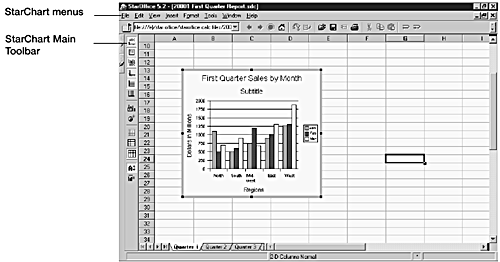Working with the StarOffice Chart Tools
You can edit and modify all the parameters related to a chart by entering the Edit mode. Doing this basically turns Calc into StarOffice Chart (while you are editing the chart). StarOffice Chart's Main toolbar will appear at the left side of the workspace and the menu bar will contain commands related to StarOffice Chart.
To enter the Edit mode, select the chart and then right-click on the chart. Select Edit from the context menu. Or, you can just double-click on the unselected chart.
Figure 10.12 shows a chart that is in Edit mode. You will find that most of the commands that you need related to editing or modifying the chart are contained on StarOffice Chart's Main toolbar.
Figure 10.12. When you are in the Edit mode for a chart, you are given access to all the commands and functions of StarOffice Chart.

Once you have finished modifying the chart, you can quickly return to Calc by clicking anywhere on the sheet outside the chart area. Let's take a look at some of the tools that StarOffice Chart provides us for modifying a chart.
To Add/Remove Gridlines
You can add or remove gridlines on a chart using the appropriate tools on Chart's Main toolbar.
1. |
Double-click on the chart to enter the Edit mode. The Chart tools become available on the Main toolbar. |
2. |
To add or remove horizontal gridlines, click the Horizontal Grid On/Off button as needed. This tool toggles between horizontal gridlines and no horizontal gridlines. |
3. |
To add or remove vertical gridlines, click the Vertical Grid On/Off button as needed. |
4. |
To save any changes that you make to the chart, click the Save button on the Function toolbar. |
To Modify Titles and Labels on a Chart
You can also modify titles and axis labels directly on a chart. As with gridlines, tools that allow you to turn off or turn on a particular label are provided on Chart's Main toolbar. For example, to remove a title from a chart, click the Title On/Off tool.
1. |
Double-click on the title or axis label. The title or label will be selected. The insertion point will appear in the selected title or label (see Figure 10.13). Figure 10.13. Double-click on a title or label to edit the text.
|
2. |
Edit the title or label as needed. |
3. |
Once you have edited the title or label, click anywhere on the chart. |
You can also move titles, labels, and the legend directly on the chart. Click on the specific item and then drag it to a new location.
To Add Data Labels
You can add data labels to data points in a chart. For example, you may wish to add a data label to each of the parts of a pie chart that provides a percentage to the whole pie area.
1. |
In the Edit mode, select one of the data points for the chart (for example, on a bar chart, select one bar on the chart to select the entire data series; in the case of a pie chart, click on one of the pie slices). |
2. |
After selecting the data point, right-click on the selected area of the chart and select Object Properties from the context menu. The Data Point dialog box opens. |
3. |
To label the selected data point, click the Data Labels tab on the dialog box (see Figure 10.14). Figure 10.14. Use the Data Labels tab to add data point labels to a chart.
|
4. |
On the Data Labels tab, select the Show value checkbox. This will place the actual value on the selected data point. |
5. |
If you wish the data label to appear as a percentage, click the As percentage option button. |
6. |
You can also choose to label a data point with associated label text from the spreadsheet; click the Show label text checkbox. |
7. |
Click OK to return to the chart. |
Figure 10.15 shows a pie chart that has its data points labeled with percentages and the associated headings from the spreadsheet.
Figure 10.15. Charts can be made more understandable by adding data point labels.

Note
You can control the font type and size used for data point labels in the Data Point dialog box. Click the Characters tab and use the various list boxes to select the font attributes.
To Change Data Point Colors
Since charts are automatically created in color, you may find it necessary to change the data point colors of a chart to shades of gray, especially in cases when you will be printing a spreadsheet and its accompanying chart to a black and white printer.
1. |
In the Edit mode, select a data point area. |
2. |
Right-click on the selected data point and select Object Properties from the context menu. The Data Point dialog box will appear. |
3. |
Select the Area tab on the dialog box (see Figure 10.16). Figure 10.16. You can manipulate the color and pattern of data point areas on a chart.
|
4. |
Use the color list to choose a new color (for charts printed on a black and white printer, select black or a shade of gray). |
5. |
To add hatching to the data point color, click the Hatching option and then select a hatching pattern from the scroll list. |
6. |
As an alternative to hatching, you can use a color gradient. Select the Gradient option and then select the gradient you wish to use the gradient picture list provided. |
7. |
To really dress up your data points, you can use bitmap pictures as a kind of wallpaper over the data point areas. Select Bitmap and then use the drop-down arrow to select a bitmap from the list. |
8. |
When you have completed editing the color options for the data point areas, click OK. |
Figure 10.17 shows a pie chart that has had all the data point colors changed to different degrees of gray and some data points have also been assigned hatching patterns.
Figure 10.17. You can customize a chart that will be printed on a particular type of printer.

Note
You can also control the border color and weight for data point areas on a chart. Use the Borders tab of the Data Point dialog box.
To Change the Chart Area Color
You can change the chart area color, which serves as the background color for the chart.
1. |
In the Edit mode, right-click on the chart (with the entire chart selected) and select Chart Area from the context menu. The Chart Area dialog box will appear. |
2. |
Select the Area tab of the Chart Area dialog box (see Figure 10.18). Figure 10.18. You can change the chart area color.
|
3. |
With the Color option selected on the tab, select a new color for the chart area. |
4. |
You can also select Gradient or Hatching options to add some pattern to the chart area background. |
5. |
To use a bitmap as a background for the chart area, select the Bitmap option and use the drop-down list to select a bitmap. |
6. |
When you have finished customizing the color options for the chart area, click OK. |
Remember that the chart area provides the background pattern and color for the actual chart. Try not to select a chart area color, pattern, or bitmap that makes the data point area of the chart more difficult to read or interpret.
To Change the Chart Type
If you find that the current chart type is not portraying the data effectively, or you wish to make a two-dimensional chart three-dimensional, you can easily change the chart type to suit your needs.
1. |
In the Edit mode, click the Edit Chart Type tool on the Chart toolbar. The Chart Type dialog box opens (see Figure 10.19). Figure 10.19. Chart types can be quickly changed using the Chart Type dialog box.
|
2. |
To select another type of chart, click the type's picture. |
3. |
To choose a variant of the current type or a new type, select the variant from the Variants list. |
4. |
To make a 2D chart a 3D chart, select the 3D option button. |
5. |
When you have made your choices in the Chart Type dialog box, click OK. |
To Restart the AutoFormat Chart Wizard
If you would like to rework an existing chart with the assistance of the AutoFormat Chart Wizard, you can quickly start the wizard as needed.
In the Edit mode, click the AutoFormat tool. The AutoFormat Chart Wizard will start. Work through the various screens to edit the current chart. When you are finished, click Create on the last wizard screen. Changes that you have made during the various AutoFormat steps will be incorporated into your chart.





